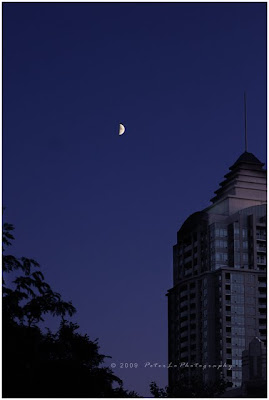
Monday, September 28, 2009
Sunday, September 27, 2009
September First Quarter Moon (上 弦 月)
Wednesday, September 23, 2009
A September Waxing Crescent Moon


A waxing crescent moon sometimes called a young moon and is always seen in the west after sunset. This is a Waxing Crescent Moon about 30% illuminated by sunshine.
You sometimes see a pale glow on the darkened portion (night side) of a crescent moon. This glow is due to light reflected from Earth’s day side. It’s called earthshine.
You sometimes see a pale glow on the darkened portion (night side) of a crescent moon. This glow is due to light reflected from Earth’s day side. It’s called earthshine.
Sunday, September 20, 2009
Closest planet/bright star-Venue & Regulus pairing predawn September 20 (金星,軒轅十四星成對)
Tuesday, September 15, 2009
Waning Cresecent Moon, Venus in east before sunrise September 16



The two brightest celestial objects of the night sky – the Waning Crescent Moon (殘 月) and the planet Venus (金星) – put on a beautiful display in Wednesday’s early morning sky. The attractive couple rises in the east about 2.5 hours before sunrise (at mid-northern latitudes), adorning the dawn and predawn hours.
Thursday, September 10, 2009
The Waning Gibbous Moon 張 弦 月 ( 虧 凸 月 )

A Waning Gibbous Moon 張 弦 月 ( 虧 凸 月 ) , is just past full and illuminated generally from the left. Valleys and highlands of the lunar surface are clearly visible. In fact, in the few days after full moon, you’ll often see the waning gibbous moon in the west in early morning, floating against the pale blue sky.
Subscribe to:
Comments (Atom)





